Energy Recovery Potential from Effluents in the Process Industry: System Dynamics Modeling and Techno-Economic Assessments
Abstract
:1. Introduction
1.1. Process Industry: Economic Importance and Effluent Generation in Food and Beverage Production
1.2. Techno-Economic Assessment of Energy Recovery Potential from Effluents
2. Concept, Materials, and Methodology
- In the discounted cash flow or net present value (NPV) method, the method determines the net present value of all cash flows by discounting them by the required rate of return (also known as the hurdle rate, cutoff rate, and similar terms), as follows:In Equation (9a) [42]:NPV is the net present value;Rt is the net cash inflow–outflows during a single period, t;i is the discount rate or return that could be earned in alternative investments;t is the number of time periods.
- The internal rate of return (IRR) is a metric used in financial analysis to estimate the profitability of potential investments. IRR is a discount rate that makes the net present value (NPV) of all cash flows equal to zero in a discounted cash flow analysis. It should be noted that IRR calculations rely on the same formula as NPV, where the annual return makes the NPV equal to zero. Generally speaking, the higher an IRR, the more desirable an investment is to undertake. Being uniform for varying project types, IRR can be used to rank multiple prospective investments or projects on a relatively even basis. In general, when comparing investment options with other similar characteristics, the investment with the highest IRR would probably be considered the best.In Equation (9b) [42]:C is cash flow at time t;IRR is the discount rate/internal rate of return, expressed as a decimal;T is the time period.To include the impact of inflation (or deflation) m where pt is the predicted rate of inflation during period n, we have Equation (9c) [42]:
- Profitability index, also known as the benefit-cost ratio, this index is the net present value of all future expected cash flows divided by the initial cash investment. (Some firms do not discount the cash flows in making this calculation.) If this ratio is greater than 1.0, the project may be accepted for Equation (10) [41]:
- Return on investment (ROI) is a performance measure used to evaluate the efficiency or profitability of an investment or compare the efficiency of a number of different investments. ROI tries to directly measure the amount of return on a particular investment, relative to the investment’s cost. To calculate ROI, the benefit (or return) of an investment is divided by the cost of the investment. The result is expressed as a percentage or a ratio in Equation (11) [42]:
- The payback period for a project is the initial fixed investment in the project divided by the estimated annual net cash inflows from the project. The ratio of these quantities is the number of years required for the project to repay its initial fixed investment. This method assumes that the cash inflows will persist for at least long enough to pay back the investment, and it ignores any cash inflows beyond the payback period. The method also serves as an (inadequate) proxy for risk. The faster the investment is recovered, the less the risk to which the firm is exposed, as in Equation (12):
3. Findings and Analysis
Limitations of the Study
4. Conclusions and Recommendations
Supplementary Materials
Author Contributions
Funding
Institutional Review Board Statement
Informed Consent Statement
Acknowledgments
Conflicts of Interest
References
- UNESCO. World Water Assessment programme: The United Nations World Water Development Report 5. In Water in Changing World Part; London Earthscan: London, UK, 2019. [Google Scholar]
- Rasul, M.G.; Ault, C.; Sajjad, M. Bio-gas mixed fuel micro gas turbine co-generation for meeting power demand in Australian remote areas. Energy Procedia 2015, 75, 1065–1071. [Google Scholar] [CrossRef]
- Jabari, F.; Arasteh, H.; Sheikhi-Fini, A.; Ghaebi, H.; Bannae-Sharifian, M.B.; Mohammadi-Ivatloo, B.; Mohammadpourfard, M. A biogas-steam combined cycle for sustainable development of industrial-scale water-power hybrid microgrids: Design and optimal scheduling. Biofuels Bioprod. Biorefining 2022, 16, 172–192. [Google Scholar] [CrossRef]
- Farooque, M.; Leo, A.; Rauseo, A.; Wang, J.Y. Efficient and ultra-clean use of biogas in the fuel cell-the DFC experience. Energy Sustain. Soc. 2015, 5, 261. [Google Scholar] [CrossRef] [Green Version]
- Mang, H.P.; Li, Z.; de Porres Lebofa, M.M.; Huba, E.M.; Schwarz, D.; Schnell, R.; Luong, N.G.; Kellner, C.; Selke, J. Biogas Production, Developing Countries. In Renewable Energy Systems; Springer: New York, NY, USA, 2013; pp. 218–246. [Google Scholar]
- Tanigawa, S. Fact Sheet | Biogas: Converting Waste to Energy; White Papers; EESI: Washington, DC, USA, 2017. [Google Scholar]
- Moomaw, W.; Barthel, M. The Critical Role of Global Food Consumption Patterns in Achieving Sustainable Food Systems and Food for All; A UNEP Discussion Paper; UNEP: Nairobi, Kenya, 2012. [Google Scholar]
- globalEDGE. Food and Beverage. 2021. Available online: https://globaledge.msu.edu/industries/food-and-beverage/memo/ (accessed on 13 September 2021).
- Belyaeva, Z.; Rudawska, E.D.; Lopatkova, Y. Sustainable business model in food and beverage industry—A case of Western and Central and Eastern European countries. Br. Food J. 2020, 122, 1573–1592. [Google Scholar] [CrossRef]
- CED. Economic Contribution of the Food and Beverages Industry; Wilson: Arlington, Virginia, 2017.
- Valta, K.; Kosanovic, T.; Malamis, D.; Moustakas, K.; Loizidou, M. Overview of water usage and wastewater management in the food and beverage industry. Desalination Water Treat. 2015, 53, 3335–3347. [Google Scholar] [CrossRef]
- Khedkar, R.; Singh, K. Food industry waste: A panacea or pollution hazard. In Paradigms in Pollution Prevention; Springer: Cham, Switzerland, 2018; pp. 35–47. [Google Scholar]
- Tommaso, G. Effluents From the Food Industry; Science, Technology and Nutrition; Woodhead Publishing: Sawston, UK, 2011; pp. 606–622. [Google Scholar]
- Hanjra, M.A.; Blackwell, J.; Carr, G.; Zhang, F.; Jackson, T.M. Wastewater irrigation and environmental health: Implications for water governance and public policy. Int. J. Hyg. Environ. Health 2012, 215, 255–269. [Google Scholar] [CrossRef]
- Maxime, D.; Marcotte, M.; Arcand, Y. Development of eco-efficiency indicators for the Canadian food and beverage industry. J. Clean. Prod. 2006, 14, 636. [Google Scholar] [CrossRef]
- Alayu, E.; Yirgu, Z. Advanced technologies for the treatment of wastewaters from agro-processing industries and cogeneration of by-products: A case of slaughterhouse, dairy and beverage industries. Int. J. Environ. Sci. Technol. 2018, 15, 1581–1596. [Google Scholar] [CrossRef]
- Kayode, O.F.; Luethi, C.; Rene, E.R. Management recommendations for improving decentralized wastewater treatment by the food and beverage industries in Nigeria. Environments 2018, 5, 41. [Google Scholar] [CrossRef]
- Hussain, R.; Sattar, S.; Khan, M.H.; Nafees, M. Low Cost Wastewater Treatment at Beverage Industry, Hattar Industrial Estate, Pakistan-A Case Study. Int. J. Environ. Prot. 2013, 3, 23. [Google Scholar]
- Chmiel, H.; Kaschek, M.; Blöcher, C.; Noronha, M.; Mavrov, V. Concepts for the treatment of spent process water in the food and beverage industries. Desalination 2003, 152, 307–314. [Google Scholar] [CrossRef]
- Tauseef, S.M.; Abbasi, T.; Abbasi, S.A. Energy recovery from wastewaters with high-rate anaerobic digesters. Renew. Sustain. Energy Rev. 2013, 19, 704–741. [Google Scholar] [CrossRef]
- Zimmermann, A.W.; Wunderlich, J.; Müller, L.; Buchner, G.A.; Marxen, A.; Michailos, S.; Armstrong, K.; Naims, H.; McCord, S.; Styring, P.; et al. Techno-economic assessment guidelines for CO2 utilization. Front. Energy Res. 2020, 8, 5. [Google Scholar] [CrossRef] [Green Version]
- Mohammed, M.; Egyir, I.S.; Donkor, A.K.; Amoah, P.; Nyarko, S.; Boateng, K.K.; Ziwu, C. Feasibility study for biogas integration into waste treatment plants in Ghana. Egypt. J. Pet. 2017, 26, 695–703. [Google Scholar] [CrossRef] [Green Version]
- Tomei, M.C.; Bertanza, G.; Canato, M.; Heimersson, S.; Laera, G.; Svanström, M. Techno-economic and environmental assessment of upgrading alternatives for sludge stabilization in municipal wastewater treatment plants. J. Clean. Prod. 2016, 112, 3106–3115. [Google Scholar] [CrossRef]
- Garrido-Baserba, M.; Reif, R.; Molinos-Senante, M.; Larrea, L.; Castillo, A.; Verdaguer, M.; Poch, M. Application of a multi-criteria decision model to select of design choices for WWTPs. Clean Technol. Environ. Policy 2016, 18, 1097–1109. [Google Scholar] [CrossRef]
- Svanström, M.; Bertanza, G.; Bolzonella, D.; Canato, M.; Collivignarelli, C.; Heimersson, S.; Laera, G.; Mininni, G.; Peters, G.; Tomei, M.C. Method for technical, economic and environmental assessment of advanced sludge processing routes. Water Sci. Technol. 2014, 69, 2407–2416. [Google Scholar] [CrossRef]
- Padi, R.K.; Chimphango, A. Feasibility of commercial waste biorefineries for cassava starch industries: Techno-economic assessment. Bioresour. Technol. 2020, 297, 122461. [Google Scholar] [CrossRef]
- Riley, D.M.; Tian, J.; Güngör-Demirci, G.; Phelan, P.; Villalobos, J.R.; Milcarek, R.J. Techno-economic assessment of CHP systems in wastewater treatment plants. Environments 2020, 7, 74. [Google Scholar] [CrossRef]
- Mofijur, M.; Fattah, I.R.; Kumar, P.S.; Siddiki, S.Y.A.; Rahman, S.A.; Ahmed, S.F.; Ong, H.C.; Lam, S.S.; Badruddin, I.A.; Khan, T.Y.; et al. Bioenergy recovery potential through the treatment of the meat processing industry waste in Australia. J. Environ. Chem. Eng. 2021, 9, 105657. [Google Scholar] [CrossRef]
- Zacharof, M.P. Grape winery waste as feedstock for bioconversions: Applying the biorefinery concept. Waste Biomass Valorization 2017, 8, 1011–1025. [Google Scholar] [CrossRef]
- Sawatdeenarunat, C.; Wangnai, C.; Songkasiri, W.; Panichnumsin, P.; Saritpongteeraka, K.; Boonsawang, P.; Khanal, S.K.; Chaiprapat, S. Biogas production from industrial effluents. In Biofuels: Alternative Feedstocks and Conversion Processes for the Production of Liquid and Gaseous Biofuels; Academic Press: Cambridge, MA, USA, 2019; pp. 779–816. [Google Scholar]
- Momodu, A.S.; Adepoju, T.D. System dynamics kinetic model for predicting biogas production in anaerobic condition: Preliminary assessment. Sci. Prog. 2021, 104, 00368504211042479. [Google Scholar] [CrossRef] [PubMed]
- Bala, B.K. System dynamics modelling and simulation of biogas production systems. Renew. Energy 1991, 1, 723–728. [Google Scholar] [CrossRef]
- Viker, D.; Richardson, G.; Luna, L. Mathematical Representation of System Dynamics Models. Online, Available from PPT–Mathematical Representation of System Dynamics Models PowerPoint Presentation-ID:425333. 2012. Available online: slideserve.com (accessed on 20 April 2022).
- FAO. Cassava Development in Nigeria; Department of Agriculture, Federal Ministry of Agriculture and Natural, Resources: Abuja, Nigeria, 2010.
- FAO. The State of Food Security and Nutrition in the World 2020; Transforming Food Systems for Affordable Healthy Diets; Food and Agriculture Organization of the United Nations: Rome, Italy, 2020. [Google Scholar]
- Adewumi, I.; Oyebode, O.; Igbokwe, K.; Aluko, O. Water footprints in four selected Breweries in Nigeria. In Towards Life Cycle Sustainability Management; Springer: Dordrecht, The Netherland, 2011; pp. 171–181. [Google Scholar]
- Pham Van, D.; Hoang, M.G.; Pham Phu, S.T.; Fujiwara, T. A new kinetic model for biogas production from co-digestion by batch mode. Glob. J. Environ. Sci. Manag. 2018, 4, 251–262. [Google Scholar]
- Gupta, A.S. Feasibility Study for Production of Biogas from Wastewater and Sewage Sludge: Development of a Sustainability Assessment Framework and its Application. Stockholm; KTH Royal Institute of Technology: Stockholm, Sweden, 2020. [Google Scholar]
- Suresh, M.V.J.J.; Reddy, K.S.; Kolar, A.K. 4-E (Energy, Exergy, Environment, and Economic) analysis of solar thermal aided coal-fired power plants. Energy Sustain. Dev. 2010, 14, 267–279. [Google Scholar] [CrossRef]
- NSDC. National Sugar Master Plan; National Sugar Development Council: Abuja, Nigeria, 2021. [Google Scholar]
- Mahmoodzadeh, S.; Shahrabi, J.; Pariazar, M.; Zaeri, M. Project selection by using fuzzy AHP and TOPSIS technique. World Acad. Sci. Eng. Technol. 2007, 30, 333–338. [Google Scholar]
- MAO, Kangyi. Engineering Economy: Overview and Application in Process Engineering Industry. 10.490 ICE. Microsoft PowerPoint—Engineering Economics Lecture.ppt. 2006. Available online: semanticscholar.org (accessed on 20 April 2022).
- Meredith, J.; Mantel, S. Project Management: A Managerial Approach with Cd; John Wiley & Sons: Hoboken, NJ, USA, 2009. [Google Scholar]
- Di Fraia, S.; Figaj, R.D.; Massarotti, N.; Vanoli, L. An integrated system for sewage sludge drying through solar energy and a combined heat and power unit fuelled by biogas. Energy Convers. Manag. 2018, 171, 587–603. [Google Scholar] [CrossRef]
- Wong, S.C.; Law-Flood, A. Tapping the Energy Potential of Municipal Wastewater Treatment: Anaerobic Digestion and Combined Heat and Power in Massachusetts; Massachusetts Department of Environmental Protection: Boston, MA, USA, 2011.
- Martin, A.; Dahl, O. District heating driven membrane distillation for advanced flue gas condensate treatment in combined heat and power plants. J. Clean. Prod. 2021, 292, 125979. [Google Scholar]
- Novakovic, V. Biomass Combined Heat and Power (CHP) for Electricity and District Heating. Master’s Thesis, Institutt for Energi-og Prosessteknikk, Trondheim, Norway, 2014. [Google Scholar]
- Akbulut, A. Techno-economic analysis of electricity and heat generation from farm-scale biogas plant: Çiçekdağı case study. Energy 2012, 44, 381–390. [Google Scholar] [CrossRef]
- Bidart, C.; Fröhling, M.; Schultmann, F. Electricity and substitute natural gas generation from the conversion of wastewater treatment plant sludge. Appl. Energy 2014, 113, 404–413. [Google Scholar] [CrossRef]
- Ochoa, A.A.; Dutra, J.C.C.; Henríquez, J.R.; dos Santos, C.A.C. Techno-economic and Exergoeconomic Analysis of a micro cogeneration system for a residential use. Acta Sci. Technol. 2016, 38, 327–338. [Google Scholar] [CrossRef]
- de Lemos Chernicharo, C.A. Anaerobic Reactors; IWA publishing: London, UK, 2007. [Google Scholar]
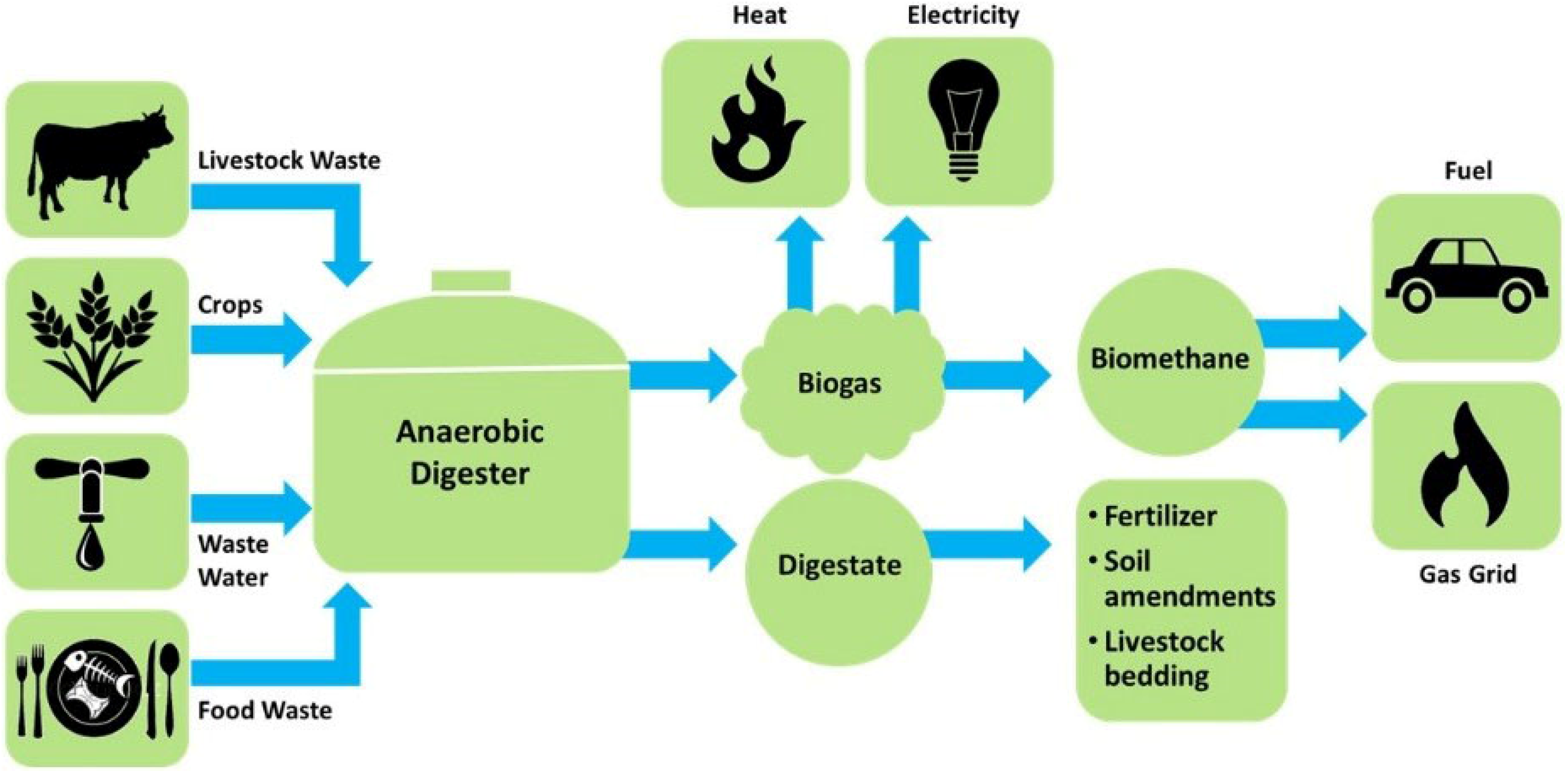

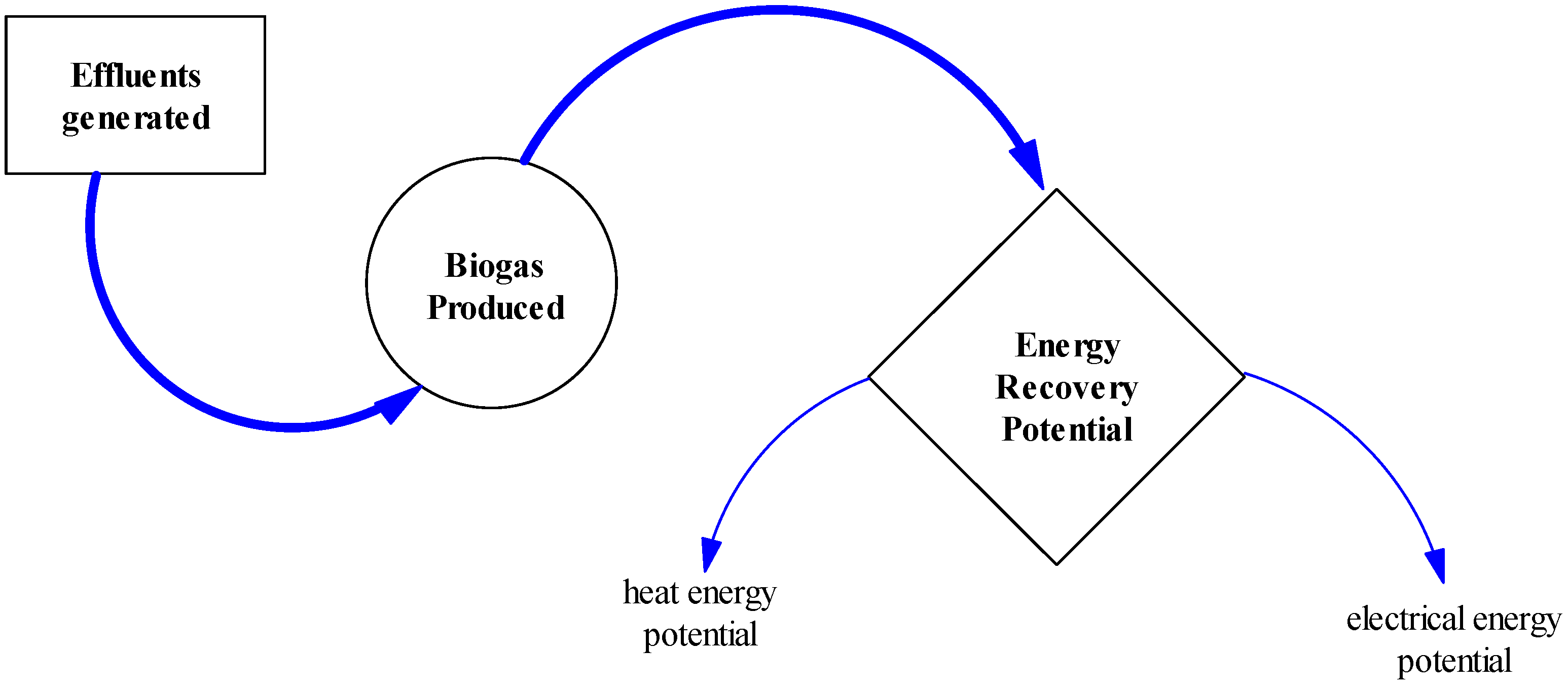

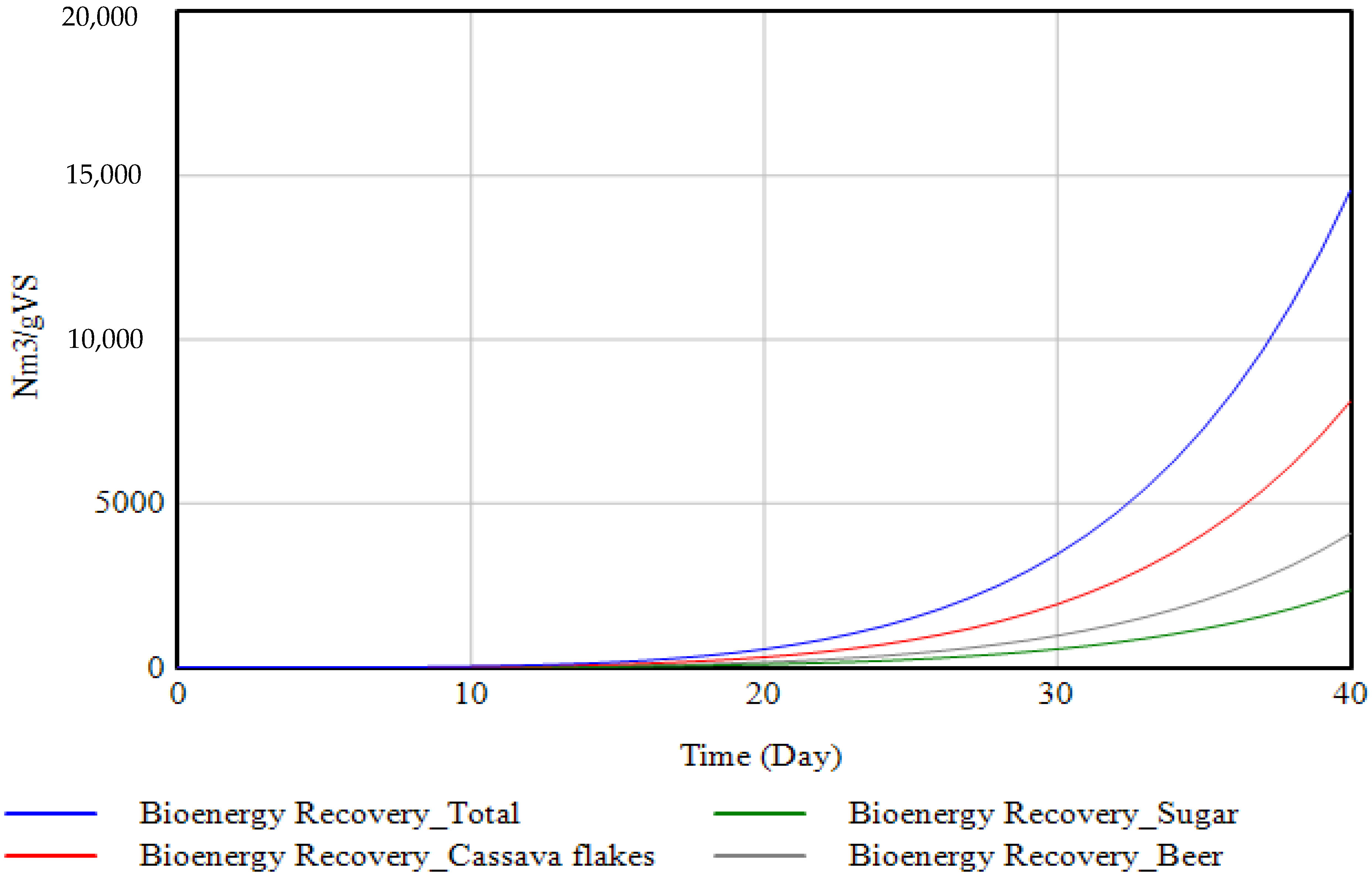
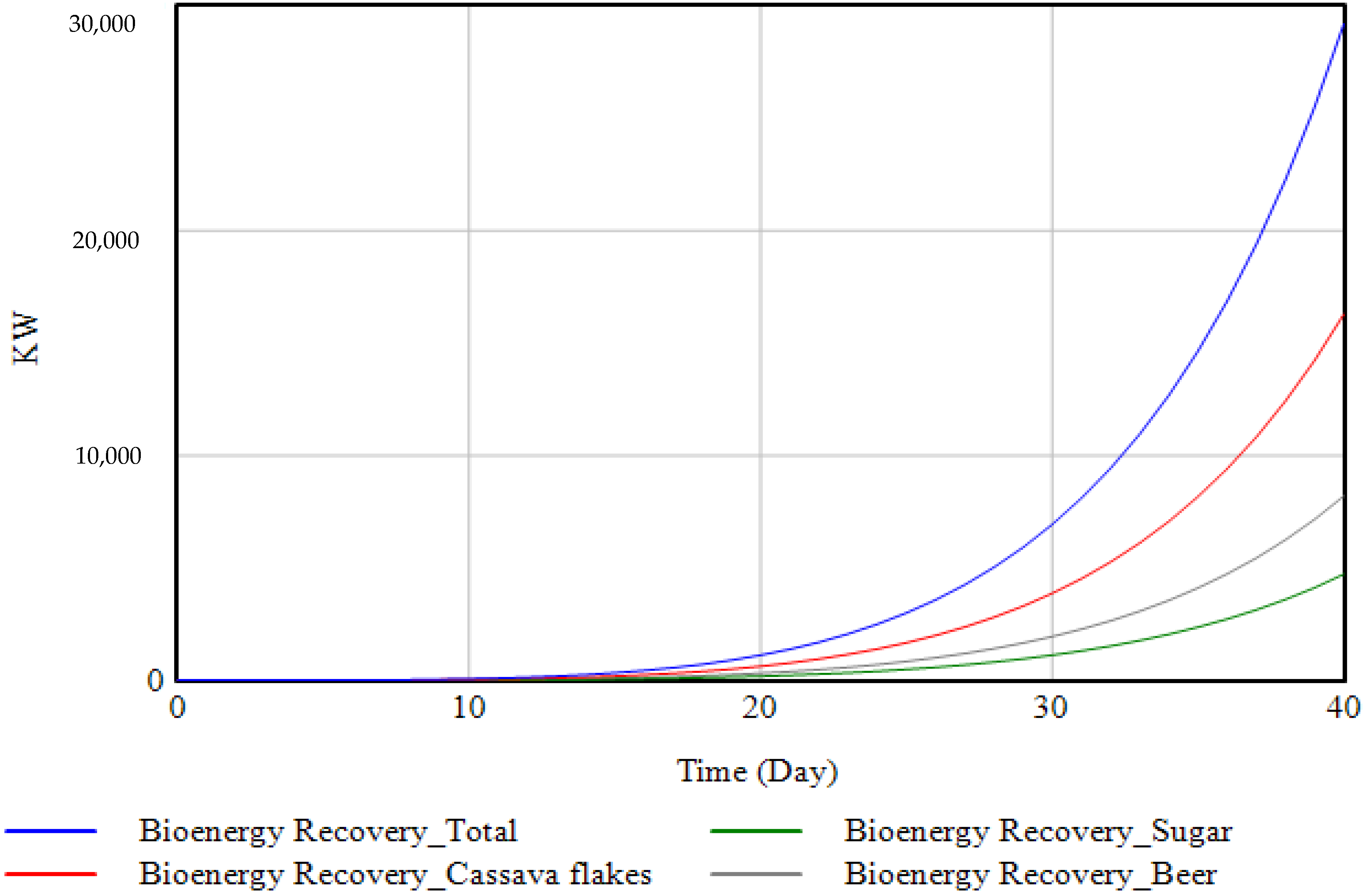
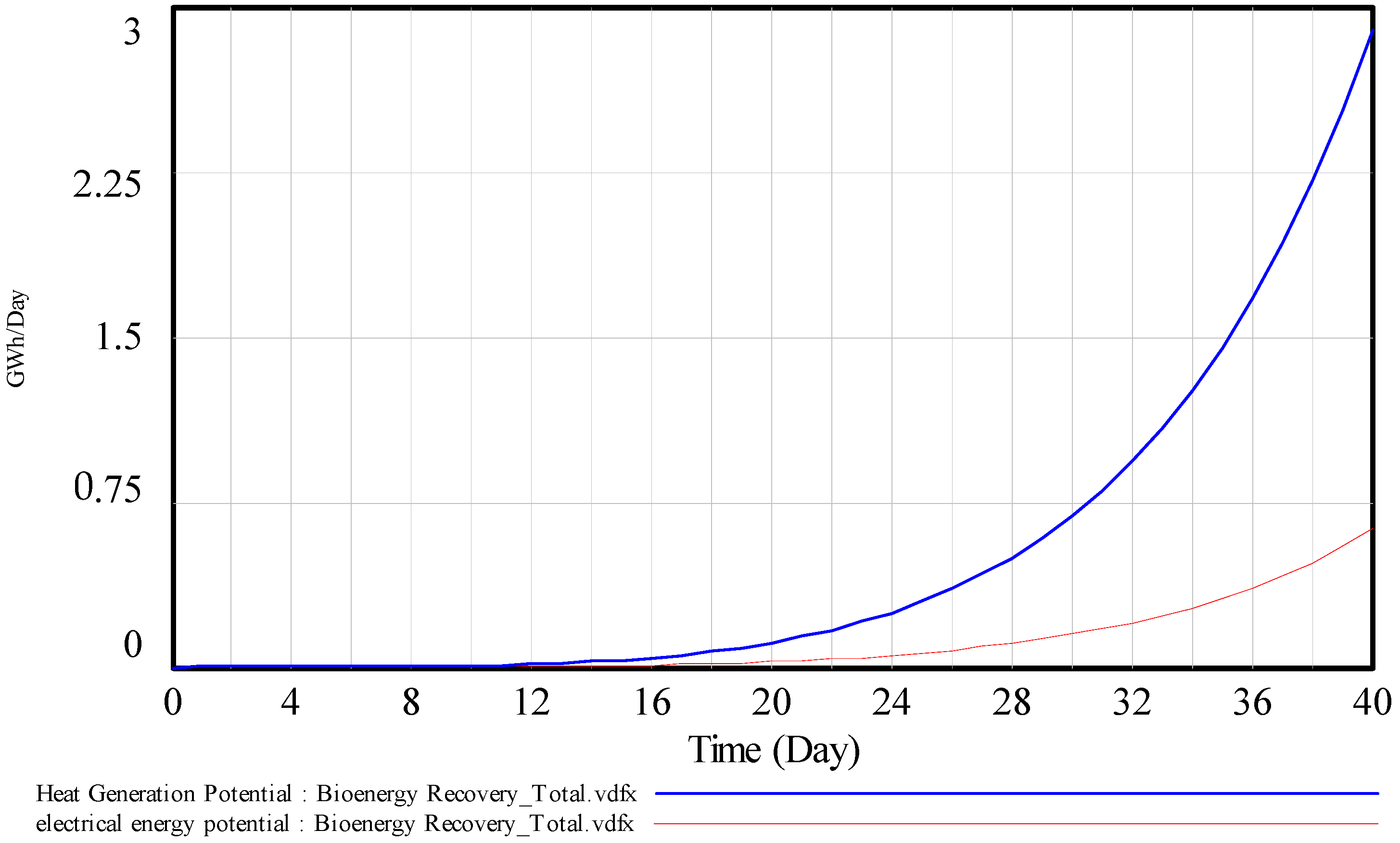
| Effluents Production from | Amount (m3/day) |
|---|---|
| Cassava flakes | 9554 |
| Beer from un-malted grain and barley | 4805.77 |
| Sugar refining | 2767.67 |
| Source of Effluents | Average Daily Heat Generation Potential (kWh/day) | Average Daily Electricity Generation Potential (kWh/day) | Total Avoided Emissions Yearly (tCO2eq) |
|---|---|---|---|
| Malted Grains | 127,924.80 | 27,648.89 | 17,264.55 |
| Cassava | 254,311.00 | 54,965.20 | 34,321.36 |
| Sugar | 73,657.78 | 15,919.94 | 9940.76 |
| All effluents | 455,893.58 | 98,534.03 | 61,526.67 |
| Turbine Type | Reciprocating Engine (RE) | Gas Turbine (GT) | Micro Turbine (MT) | Fuel Cell |
|---|---|---|---|---|
| Project Indicators | ||||
| Power Generating Capacity needed (MW) | 5.2 | 5.2 | 5.2 | 2.0 |
| Levelised Cost of Energy (LCE) ($/kWh) | 0.06 | 0.07 | 0.08 | 0.09 |
| Project Type Economic and Financial Indicators | Reciprocating Engine (RE) | Gas Turbine (GT) | Micro Turbine (MT) | Fuel Cell |
|---|---|---|---|---|
| NPV of profit margin (millions of dollars) | 7.9 | 6.79 | 3.59 | 2.42 |
| ROI (%) | 46 | 41 | 16 | 10 |
| IRR (%) | 45 | 36 | 34 | 32 |
| Payback period (years) | 6.09 | 6.63 | 8.09 | 7.69 |
| Profitability index (cost-benefit ratio) | 1.50 | 1.39 | 1.17 | 1.12 |
Publisher’s Note: MDPI stays neutral with regard to jurisdictional claims in published maps and institutional affiliations. |
© 2022 by the authors. Licensee MDPI, Basel, Switzerland. This article is an open access article distributed under the terms and conditions of the Creative Commons Attribution (CC BY) license (https://creativecommons.org/licenses/by/4.0/).
Share and Cite
Adepoju, T.D.; Momodu, A.S.; Ogundari, I.O.; Akarakiri, J. Energy Recovery Potential from Effluents in the Process Industry: System Dynamics Modeling and Techno-Economic Assessments. Fuels 2022, 3, 627-641. https://doi.org/10.3390/fuels3040038
Adepoju TD, Momodu AS, Ogundari IO, Akarakiri J. Energy Recovery Potential from Effluents in the Process Industry: System Dynamics Modeling and Techno-Economic Assessments. Fuels. 2022; 3(4):627-641. https://doi.org/10.3390/fuels3040038
Chicago/Turabian StyleAdepoju, Tofunmi D., Abiodun S. Momodu, Ibikunle O. Ogundari, and Joshua Akarakiri. 2022. "Energy Recovery Potential from Effluents in the Process Industry: System Dynamics Modeling and Techno-Economic Assessments" Fuels 3, no. 4: 627-641. https://doi.org/10.3390/fuels3040038
APA StyleAdepoju, T. D., Momodu, A. S., Ogundari, I. O., & Akarakiri, J. (2022). Energy Recovery Potential from Effluents in the Process Industry: System Dynamics Modeling and Techno-Economic Assessments. Fuels, 3(4), 627-641. https://doi.org/10.3390/fuels3040038








